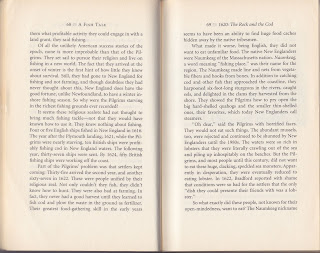The Elements of Typographic Style – Robert Bringhurst
I've chosen to show only non-fiction and reference books here because these were the most interesting layout examples that I could find. Fiction page layout seems generally to be conventional – but no doubt there are some great exceptions.
Ghost Colonies: Failed utopias, forgotten exiles and abandoned outposts of empire – Ed Wright (Pier 9, 2009)
The dimensions of this book are unusual. It measures 185 x 228 mm and is thus relatively wide in relation to its height. An elegant two-column option has been used for the main text grid, as shown above. The top margin is also generous to allow ample space for the running headers. In my opinion this is a successful solution for non-fiction narrative text. The short measure allows the reader to comfortably digest information, but it can also be read without significant interruption.
There are sections of the book, not shown here, where the text has been set in one column in order to emphasise information that is not part of the main text. In these instances, the outer margin has been increased significantly so as to avoid an excessively long measure.
Collins Gem English Dictionary (HarperCollins, 2001)
This basic, pocket-sized dictionary is, by contrast, of very modest dimensions (75 x 115 mm). It also uses a two column grid; however, the margins have been compromised to the last degree.
This is not to say that the page is particularly displeasing to the eye and it is certainly not unsuitable to the type of information it houses. The typographical choices (offsetting text using roman, bold and italics) lead to a well balanced result.
Cod: A Biography of the Fish That Changed the World – Mark Kurlansky (Vintage, 1999)
This book is thoroughly engaging and reads rather like fiction and seems designed as such. Its design is also a clear example of how keeping to convention sometimes just is the best solution. The bottom margin is the largest, being approximately one and a half times the size of the top. One can comfortably sit one's thumbs there when holding the book to read (a design guru said this was desirable, but sadly I've forgotten who that might have been).
I do wonder whether I would have so readily devoured a book about the history of the world's cod fisheries had the text been squeezed into a tight grid without room to breathe.
Roosters I Have Known – Steve Braunias (Awa Press, 2008)
A tidy format – Penguin Classic-like. I do think though that the text on the page has been compromised the littlest bit too much. The book is quite stiff and consequently the text slips into the gutter a little and it is a bit uncomfortable to read.
Super Natural Cooking – Heidi Swanson (Celestial Arts, 2007)

Finally, here's a book that works at the boundaries of conventional layout. The top and outside margins are minimal relative to the bottom and gutter margins. I imagine this has been done to reflect the book's subject matter, as communicated by the title. It feels as if the text has been manually pushed up and outwards from the middle to the edges. Running heads have been omitted, but folios are located on the bottom outside corner of the pages (outside the scanner area).
Super Natural Cooking – Heidi Swanson (Celestial Arts, 2007)

This cookbook has an interesting and flexible grid. These images show a recipe that sits across a two-page spread. A fair amount of information is displayed here, yet the pages are well balanced with generous white space. Throughout the book, a series of flexible text blocks are used to display different textual elements, which are shifted around the page to suit the amount of information being displayed.
Sprawltown: Looking for the city on its edges – Richard Ingersoll (Princeton Architectural Press, 2006)
Finally, here's a book that works at the boundaries of conventional layout. The top and outside margins are minimal relative to the bottom and gutter margins. I imagine this has been done to reflect the book's subject matter, as communicated by the title. It feels as if the text has been manually pushed up and outwards from the middle to the edges. Running heads have been omitted, but folios are located on the bottom outside corner of the pages (outside the scanner area).






No comments:
Post a Comment